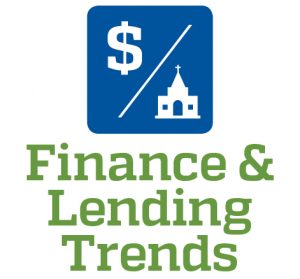
By Dan Mikes
 Developing a plan for physical plant expansion for a growing ministry is complex and lengthy. Assessing current and future space needs, and conceptualizing a design that functions well with your ministry’s personality and your development site’s physical characteristics, the process must synchronize with financial capacity.
Developing a plan for physical plant expansion for a growing ministry is complex and lengthy. Assessing current and future space needs, and conceptualizing a design that functions well with your ministry’s personality and your development site’s physical characteristics, the process must synchronize with financial capacity.
To assure that the financial means of your congregation align with the cost of your new facility and your target break-ground date, identify your fundraising ability and borrowing capacity as early as possible.
 While I don’t claim extensive capital pledge campaign expertise, in my third decade as a lender to religious institutions, I have tracked the pledge campaign collection results of several hundred pledge campaigns. Standard loan covenants require ministry borrowers to provide annual financial statements to the lender throughout the life of the loan. Consequently, I have seen the results of internally and professionally orchestrated capital pledge campaigns.
While I don’t claim extensive capital pledge campaign expertise, in my third decade as a lender to religious institutions, I have tracked the pledge campaign collection results of several hundred pledge campaigns. Standard loan covenants require ministry borrowers to provide annual financial statements to the lender throughout the life of the loan. Consequently, I have seen the results of internally and professionally orchestrated capital pledge campaigns.
Accordingly, I firmly believe hiring a professional fundraiser is in your congregation’s best interest. This expert will typically guide your institution to a higher pledge total, and the pace and rate of collections against those pledges will be more predictable. This can help you qualify for a larger loan. The predictability of the actual pledge revenue streams enables the experienced religious institution lender to give greater weight to your pledge campaign funds in calculating your borrowing capacity. So, interview a few fundraisers early. Get their opinions as to a reasonable pledge target.
When it comes to borrowing, cash flow is important. However, experienced ministry lenders understand that houses of worship typically do not spin off significant excess cash flow. Consequently, when the lender analyzes your previous three years of financial performance, the annual “cash-available-for-debt-service” will not likely be on par with the level of debt needed to fund the physical plant expansion your donors want and need.
After establishing a solid perspective on your fundraising capability, sit down with an experienced lender who can work with you to layer your borrowing capacity into your overall plan. Again, it is imperative to have these two meetings early in your planning cycle. Otherwise, leadership might end up having to walk back a prematurely cast vision concept. Having to downsize the renderings (which have already been hung in the lobby) hurts confidence in leadership and hinders fundraising.
Based on a well-conceived pledge campaign target, a seasoned religious institution banker can work with you to develop a “roadmap” which specifies your borrowing capacity based on a forecast of pledge receipts during the three to six months preceding the loan closing and groundbreaking. Experienced lenders know what the first few months of a healthy and predictable campaign look like. Applying for the loan at that point can provide the lender with evidence of increased capacity to service debt.
The assumptions underlying the roadmap enable a timeline that begins with the launch of the pledge campaign; identifies the timing for loan application; specifies the formula which could yield a sufficient upfront loan commitment; approximates the post-construction and post-campaign debt load and related annual debt service; and ends by defining the extent to which a subsequent softer fundraising effort might be needed to supplement the increased operational cash flow coming from your larger building and the congregational growth it will likely enable. If this sounds overwhelming, just remember — if you are dealing with an experienced church lender — that all you need to bring to the table is three years of financial statements and your capital pledge target.
An intersecting topic when planning your project is the balancing of “Sources-and-Uses” — industry jargon which means your Total Project Costs must equal your Cash Contribution, plus your Loan Commitment. Also consider the timing of the cash contribution.
Typically, the ministry’s business administrator will build a cash flow model which forecasts pledge receipts during construction, the construction draw disbursements, the monthly debt service, etc. One of the byproducts of doing so is to identify the high-water mark on the construction loan. Said another way: During construction, each month you will use your incoming pledge receipts to fund construction costs, thereby limiting the amount you need to draw against your construction loan. Consequently, when defining your Sources-and-Uses, the common mistake is to equate that high-water-mark on the construction loan with your needed Loan Commitment. This could prove disastrous.
When you are ready to affix your institution’s good name to a construction contract, you want to be absolutely certain that — no matter what happens the next day, week or month — the funding is wholly in place. Consequently, your Loan Commitment should be based on your Total Project Cost, minus your Cash Contribution as of loan closing. If, for some unforeseeable reason, the capital pledge revenues drops off a cliff the day after you sign a construction contract, you won’t have to worry about a failed construction project, legal disputes with unpaid contractors, and damage to donor confidence.
With a roadmap, a clear picture of sources and uses, and an experienced lender, you are well on your way to your goal of funding the building your growing congregation needs.
Dan Mikes is Executive Vice President and National Manager of the Religious Institution Division, Bank of the West, San Ramon, CA. Opinions rendered in this article represent the author, and not Bank of the West.


